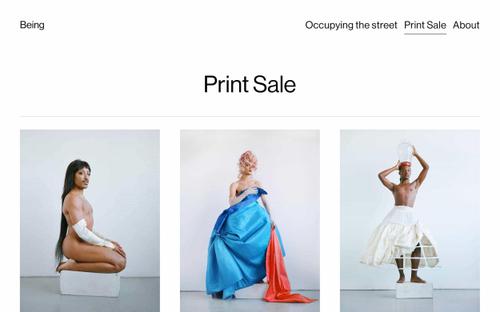Download our free workbook and get started on your action plan to launch your business
The email you entered is invalid.
Thank you for subscribing.
By entering your email, you indicate that you have read and understood our Privacy Policy and agree to receive marketing from Squarespace.
Ecommerce has created opportunities for so many brands, ideas, and styles to thrive. There’s a buyer for nearly everything available online.
For business owners and new entrepreneurs, it might be worth considering creating an online boutique. Online boutiques have subtle differences to traditional ecommerce websites. An online boutique is ideal for an independent business owner who understands trends, and is obsessed with fashion, design, accessories, or niche objects.
Here’s what you need to know about online boutiques, starting your own, and what to consider before beginning.
What is an online boutique?
An online boutique is a subset of ecommerce, and is still a digital storefront. But a boutique offers specialized products, often apparel, such as seasonal trends or specific styles, or handmade items. Think of a chic, one-of-a-kind handmade mug you can’t find in a major home goods store. Online boutiques often pursue original and limited items by artists or makers to sell.
Because of the unique nature of most products found in an online boutique, pricing and availability are usually quite different from major online stores.
For example, that one-of-a-kind handmade mug may cost much more than one found from a big box brand because its maker only made a few, and is including their labor in the price. The same applies to luxury online boutiques that feature fashion designers with limited stock quantity or seasonal items.
What’s special about online boutiques?
Online boutiques offer a unique opportunity to build a business on a smaller scale. Technological advancements have made it easy for businesses and entrepreneurs to start and grow brands without physical retail spaces.
They also offer flexibility: An online boutique can have in-person pop-ups or sell at markets, even if most of its business comes from social media, a website, or a third-party marketplace.
For customers, boutiques offer access to exclusive, rare, or one-of-a-kind products they can’t find elsewhere.
8 steps for starting your online boutique
Starting an online boutique takes a little time, strategy, and some experimentation. If you're new to online boutiques and would like to try a hand at your own, this step-by-step guide can kickstart your journey.
1. Find your boutique’s niche
Before coming up with the boutique’s name or deciding on which products to sell and what the brand design should be, you need to understand and pursue a specific niche. Let passion and curiosity drive you toward your business idea. Comb through your hobbies, interests, and any exciting ideas you may have.
For example, if you’re passionate about art, and have a catalog of illustrations, paintings, or designs of your own or other local artists, you may want to sell that. Some online boutiques rely on sourcing and creating products, while others can work in collaboration with other creatives and makers to sell on their behalf.
Whatever the case, your online boutique needs to speak to both your own interests and expertise, something that allows you to create something that stands out and connects with an audience of potential buyers.
2. Create a business plan
No ecommerce venture is complete without a strategy behind it. Write a business plan that will guide your online boutique, set goals, flag potential risks and challenges, and clarify anything you may need to launch and grow your business successfully.
Your business plan should answer a critical question: What are the goals of my online boutique? It doesn’t have to be formal, but it can help you organize your thoughts and have a record to return to.
Read our guide to creating a business plan
3. Develop products and source them
Once you’ve decided on what your niche is and what the shape and goals of the business will be, it’s time to figure out which products to sell.
For example, an online boutique specializing in apparel will need to decide if they’re sourced through a wholesaler or retailer, or even handcrafted.
Some ways of sourcing products include:
Dropshipping: A third-party stocks inventory and fulfills orders
Resale: Products purchased from wholesalers or retailers
Handmade: Products made by the boutique’s owner or other makers
Print on demand: Products designed by an individual but produced and fulfilled by a third-party
It’s important to pick a method that works for you, your budget, and the brand you’re developing. Some online boutiques might be a mix of product sourcing methods. When sourcing or developing products, consider your niche and target customer. Are handmade items expected? What design style or packaging are they looking for?
4. Price products
Pricing your products well ensures you’re recouping your labor, production, and tax costs and generating a profit.
Understanding the market your online boutique fits in will help you determine an effective pricing strategy. How do other boutiques in your niche compare? If you’re pricing too high, customers may seek out other stores to satisfy their needs and wants. Priced too low, and you may be undervaluing the uniqueness and labor that went into making the products.
Learn more about pricing strategies
5. Develop the boutique’s brand
Your brand is a vital tool for connecting with customers. A brand includes visual, design, and aesthetic elements, storytelling and values, and voice and tone. All of these aspects work together to form an impression of your business. The more cohesive the brand identity, the better it can connect to customers.
It helps to return to your target customer when developing your brand. Ask yourself: If your brand were a person that your target customer would like or aspire to, what would they be like? Would they be calm and soothing, or bold and eclectic? These can help you develop a brand personality that informs your branding decisions. With a boutique, the brand is often reflective of the owner and their interests and values.
Learn how to create your brand personality
6. Create your website
A website is the base of operations for your online boutique. Your site isn’t just your storefront, it’s one of the first places potential customers will look for information about you and your store.
To get started, we recommend your website includes:
Custom domain name: This unique URL typically matches your store or brand name and makes your site easier to find online.
Clear navigation: Ensuring it’s simple to find your store, shipping information, and other important store details keeps visitors on your site, making them more likely to browse and buy.
High-quality product pages: Quality product photos and descriptions go a long way toward convincing shoppers to buy something they can’t see in person.
Brand and about us pages: Use your site to further drive home your brand design and story. Visitors are looking for the personal touch of a small boutique, so share details to help them feel connected to you.
Contact details: In addition to linking your social media, make sure you have a form or email for visitors to reach out to with questions.
Payment flexibility: Offering multiple payment options, like buy now, pay later, digital wallets, and traditional card payments, makes shoppers more likely to finish checking out.
Shipping and returns: Make sure these details are clearly stated or linked on your checkout page, so customers feel confident about when they’ll get their items and that they can return them if they need to.
Ecommerce website builders like Squarespace can support boutique owners with the right features and pages to create a website that reflects their brand.
7. Make a shipping and fulfillment plan
Streamlining your fulfillment and shipping process for your online boutique will be important to ensure your products are getting to customers in a timely manner. Many customers expect overnight or speedy shipping and delivery. However, for products that are high-quality and coming from a small business, they’re often willing to wait.
Your fulfillment process will look different depending on how you source your products. For example, if your online boutique features local artisans, then your shipping may be locally focused, too, and not available for international customers. It may also mean, depending on your product inventory, that you handle the shipping and fulfillment yourself.
You’ll also need to consider:
Where you’ll ship: Domestic or international shipping
Shipping costs: Estimates, standard shipping fees, or free shipping options
In-person fulfillment: Local pick-up or delivery
Overnight or rush delivery: Availability and costs to you
Shipping and returns policies: Time to ship, restrictions, and return guidelines
Eco-friendly packaging: Options and feasibility for your budget
8. Promote your boutique
Once you’ve set up your online boutique, received all of your products, and figured out how to get them to customers, the last step is to start promoting it.
First and foremost, return to your ideal customer. Then, consider your brand’s value. This will help you identify what to highlight about your boutique, where, and to whom.
Next, set up a social media business account. It can be helpful to have an account on multiple platforms to reach potential customers across channels, but it’s OK to start with one platform that fits your business. For example, for highly visual online boutiques, consider using a visual platform for your primary account.
Start by getting the word out among your network. Share your website on your personal and professional social media and with friends and family, and ask them to share too. Consider building excitement with a soft opening period or early customer discounts.
Other ways to promote your business include:
Influencer marketing: Collaborate with influencers with similar style or values to yours to reach their audiences.
Paid ads: Run paid ads, targeting specific audience segments that fit your ideal customer.
Email marketing and newsletters: Stay top-of-mind with regular updates on your store, new products, and sales.
Search engine optimization (SEO): Research and target specific keywords in your product descriptions to appear more prominently in search results and bring in high-intent buyers.
What to consider before setting up an online boutique
Setting up an online boutique takes time, patience, and thoughtful analysis, with some trial and error. There are going to be things outside of the business plan that pop up every now and again.
While not an exhaustive list, here are a few things to consider before setting up your online boutique.
Cover your legal bases. Depending on your boutique’s unique offering, you may have some legal responsibilities and risks. Licenses and reseller agreements may be required to sell someone else’s work. Research and consult a legal expert to cover all of your bases.
Sales won’t come overnight. Brand awareness takes time. Customers will need to discover your boutique. Today’s buyer is also very discerning, preferring to give their money to brands they trust—and that trust takes time to build. Be patient and continuously work toward your goals.
Remain nimble. You may need to pivot or make changes to your online boutique because of unforeseen challenges. Changing your strategy based on sales or feedback is normal for any business. Knowing when and how to make those changes will help you land on the right approach sooner.



